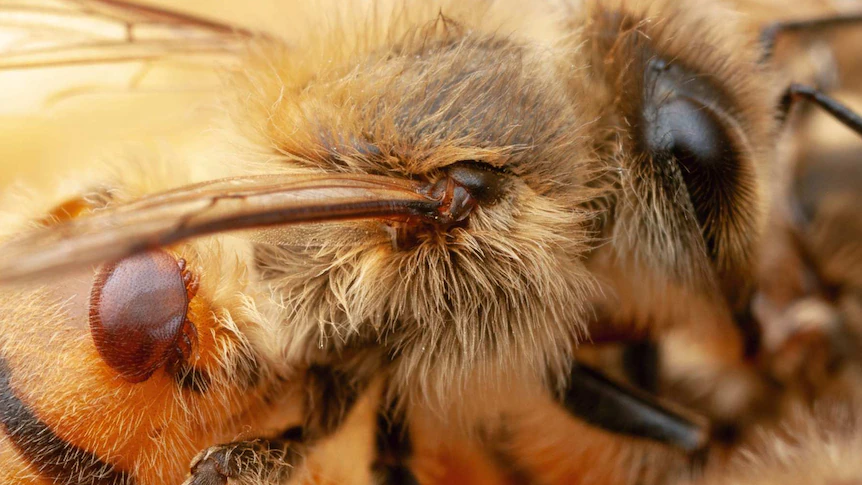



Article by: Hari Yellina
The fatal varroa mite, according to bee specialists, has been present in Newcastle, in NSW’s Hunter area, since the summer. The bee parasite was discovered for the first time in Mayfield two weeks ago, but according to Dr. Cooper Schouten of Southern Cross University and other experts, it has actually been around for much longer. According to Dr. Schouten, an expert in honey bee research, “it’s difficult to determine exactly how long they have been here but, given the densities of mites in some hives, it’s probable they have been here since summer.” When asked if this raised question about the outbreak’s origin, he responded, “Based on the evidence from surveillance thus far, Newcastle is the epicentre.”
The parasite would have “been here for longer than six months before it got to the sentinel hives” (used for early detection of illnesses and pests), according to modelling, an NSW Department of Primary Industries [DPI] biosecurity officer reportedly told one beekeeper. Varroa mite was discovered for the first time on June 22 at “two properties in Mayfield and Mayfield West,” according to the NSW government’s emergency order for the situation. In Mayfield, close to the Hunter River and Port of Newcastle, one of these locations had sentinel hives at the back of a building. The mite had moved to other locations in NSW, according to insiders, from the other site, which was a commercial bee operation.
The beekeeping industry has referred to this facility as “ground zero” of the pandemic. There is no explanation for how the mite got to Newcastle. The mites “would have come via a cargo ship or via illicit importation of queen bees,” according to Dr. Schouten. This question can be answered more effectively with the help of the data, which will reveal where each person is from. The 50-kilometer emergency zone around Newcastle is where the NSW DPI has declared it would track every movement of hives and equipment “during the previous 12 months” on and off farms. Because of this, beekeepers began to wonder how long the parasite had been present in Newcastle.
DPI did not react to inquiries on this problem. “Tracing is a vital aspect of every response and is a focus for us as we eradicate varroa mite in NSW,” the DPI stated on its website. We will have all the data we need to carry out this surveillance job if we collect a full year’s worth of data on the purchase of honeybees from the Newcastle area. Some beekeepers think the mite won’t be completely eliminated by DPI. No nation has ever accomplished this before. Concerns have also been raised about DPI’s capacity to euthanize bees and destroy hives in time to stop the spread.
Then it took them an additional three days to kill the bees and an additional two days to remove and destroy the hives. The beekeeper went on to say that he was shocked that five persons, as opposed to one or two, were sent to his location to verify the outcome. A spokesperson for DPI responded to a question about the number of staff members working on the response strategy to euthanize bees and destroy hives by saying, “This varies daily but on Wednesday we had 147 people on duty, including five industry liaison officers and 34 other people, which includes volunteers.” There were “17 teams in the field, comprising of 95 personnel” on Thursday.
The DPI representative responded when asked how long they anticipated it would take to euthanize bees and destroy hives: “While we are on a programme to eradicate varroa mite in Australia, we will continue to euthanize afflicted honeybees and hives.” On Monday, DPI expressed greater hope, stating that it had “a good opportunity to eradicate this biosecurity concern and stop the advent of the varroa mite.” “DPI has implemented major measures to halt the threat’s propagation.” By Wednesday, there were 28 afflicted locations in the Hunter, including new discoveries in Berry Park, Heatherbrae, Seaham, and Hinton. By Thursday, there had been three additional Hunter detections at Campvale, Holmesville, and Glen Oak. This increased the overall number of infested premises to 34.
Bees and hives have been destroyed by DPI. Honeybees in 1270 hives had been put to death on Wednesday at 6 p.m. In 1693 hives, honeybees had been put to death by Thursday at 6 p.m. 11,124 hives were recorded by the DPI on Thursday in eradication zones. For beekeepers, it has been an emotional period. On Thursday, Hunter Valley Amateur Beekeepers Club vice president David Vial had his bees put to sleep. With roughly 150 hives, he established a beekeeping operation near Williamtown where he raised queen bees and sold honey. “My entire business, including all of my hives and the genetics of my queen bees, is gone. I’m wrecked,” said he. When the killings occurred, he left for a drive, saying, “I couldn’t be there.”
“The government is benefiting from this chilly winter. The bees prefer to stay indoors, where it is cosy and warm. We’re in trouble if they can’t control positive hives by September 1,” he said. “In spring, they could never contain it. The busiest months for bees are September and October. There won’t be any bees to pollinate our food supply, which is a necessity. That’s the terrifying part. If it spreads, the rest of Australia will also face difficulties.”